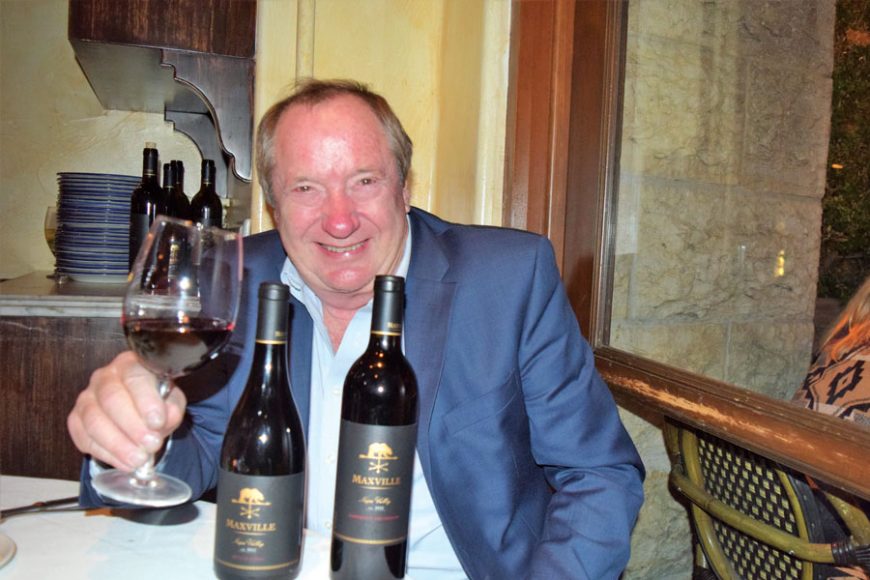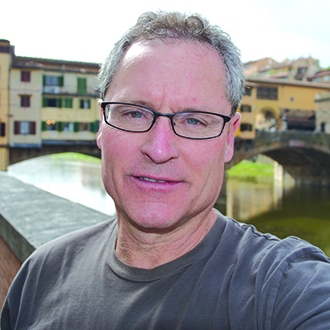Recently, I was invited to a wine dinner with California consultant and winemaker George Bursick to discuss and taste his wines from Maxville Winery. Usually I do a bit of research prior to a sit-down so I have some background. I didn’t get a chance to do that this time. One of my first questions was “Why have I not heard of Maxville before?” George told me, “Because Maxville winery is recently built and brand new to the New York market.” Then George poured us a glass of his 2016 Sauvignon Blanc and began to tell the story of Maxville.
George is dynamic, charismatic, hearty, affable and fun. His stories are great and his laugh, contagious. And his story in the wine world is a bit
unusual. He was studying botany and plant physiology and took an entry-level job at Beringer Vineyards, also in St. Helena, California. Most winemakers come to the career of wine through a family history or connection or an inherent fantasy of the product or the lifestyle. Beringer winemaker Myron Nightingale saw something in George and strongly urged him to complete his plant physiology degree and then study oenology at University of California at Davis, one of the few wine schools in the United States at the time. In the early 1970s in the U.S., wine lovers tended not to buy California wines. French, Italian and German wines were taken seriously and had centuries of experience and their wines were very good and affordable. California wines tended to be bulk made wines sold in big jugs for fast drinking or for religious ritualistic purposes.
With his plant physiology degree, George joined a class of 35 at UC Davis. Graduating in 1976 with oenology degrees, all 35 had jobs waiting for them and it is not an overstatement to say this class, with Paul Hobbs, David Ramey, Kathy Corison and Mike Martini among others, changed the wine world significantly for the better. I asked George, “With that cast of characters, you must have a story or two about your time there.” He said, “I was a couple of years older and ended up with the keys to the distillation room. After hours we would go in, without faculty, and taste spirits from the early years of the century. That was a bonding experience.”
Virtually all the winemakers I have met agree that “great wine comes from great fruit.” His deep understanding about plants gives George a significant advantage. He took a job as vice president and winemaker at McDowell Valley Vineyards, then got recruited to help build the Ferrari-Carano Vineyards and Winery from the ground up and make their wines. He put in more than two decades there where he won numerous awards for the wines, which allowed the place to expand and buy more acreage. He then worked at J Vineyards & Winery to create luxury and iconic wines.
Eventually, George wanted to slow things down a bit and he began to step aside to expand his consulting business of helping others realize their wine world dreams. But then Travis Li, a wealthy Chinese mega barley producer, heard of George and his skills and his background. Li wanted to build a boutique, high-end winery from the ground up.
Property in Napa Valley proper is expensive and difficult to find. So they researched and tested soils around Chiles Valley, part of Napa and a recognized American Viticultural Area since 1999, although grapes have been planted there for many decades before that. Chiles Valley is nestled into the Vaca Mountains in the northeast side of Napa. Before long they settled on a site that looked perfect and even had some small plots of long abandoned grape vines growing. The advice was to tear out these vines and start over. But with that plant physiology degree, George decided to rehab and fertilize the vines and today these vines contribute to some of the Sauvignon Blanc blends. Chiles Valley has an altitude of 900 to 1,200 feet and is cooler than much of Napa. This allows for slow development of flavor and deep color while retaining natural acidity. The changing climate is likely to make the Chiles Valley even more attractive.
Maxville has about 100 acres planted in the noble varietals — Sauvignon Blanc, Cabernet Sauvignon, Cabernet Franc, Merlot, Malbec, Zinfandel, Petite Sirah and Petite Verdot. And again, George’s background allowed for planting the right grape stock in the right soil. The 2016 Sauvignon Blanc sells for $30 and is floral, structured and perfumey, with balanced lemon citrus notes. Our next wine was the 2015 Maxville Cabernet Franc, showing dark cherry notes with an attractive spiciness and great aromatics. This wine is well-balanced and delicious. The 2015 Cabernet Sauvignon was elegantly powerful with dark fruit, cedar, vanilla and dark pepper. And the 2015 Petite Sirah presented dark fruit and cinnamon with a textured, silky finish.
These reds retail around $60 but are well worth it. They are available in stores and restaurants as well as on MaxvilleLakeWines.com. Take a look at the site and go on a 53-second gorgeous video tour of what Li and George have created. I’m not sure when the last Napa startup wine company began but Maxville wines are new, wonderful and delicious. I would be happy to drink them now but cellaring a few for a few years should give a significant reward.
Write me at doug@dougpaulding.com.


